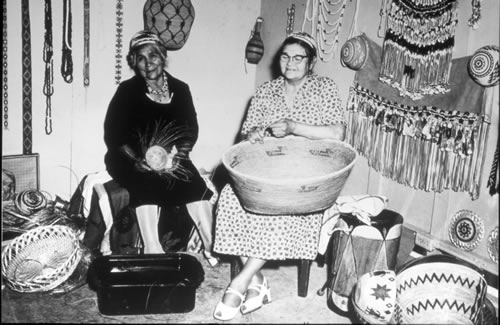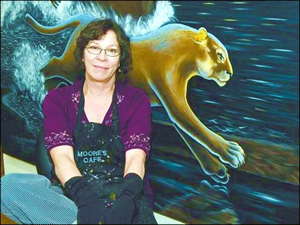Marie Potts and Judith Lowry
The growing awareness of the Native Californian self-reliance movement has led to a resurgence, or perhaps resurfacing, of programs related to Sierra Nevada Indian communal development and heritage. Native authors, painters, photographers, linguists and historians have led a sophisticated social and cultural renaissance in recent years, building upon the admirable efforts of those who toiled in the shadows in previous decades. The roster of these cultural pathfinders is an impressive and heartening assembly, following an old but newly illuminated trail. Here are two examples:
An early leader was Marie Potts, a Northern Maidu from Plumas County. Originally named Chankutpan—"one with sharp eyes"—Potts was a pioneer in securing legal and cultural rights for Native Americans. Marie established the American Indian Press Association, was a founder of the Federated Indians of California Inter-Tribal Council, and was the originator of Smoke Signal, one of the first Indian newspapers in the United States. Just prior to her death in 1978 at age 83, Marie Potts wrote The Northern Maidu, an evocative remembrance of her childhood that considered her community history and culture. The book includes this soulful reminiscence of a memorable moment from her youth:
I also remember as a child living in the cedar bark house with my grandparents. How wonderful it was, lying awake at night sometimes, to hear the coyotes bark, and the hoot owls uttering their calls among the trees. Sometimes there would be the running clatter of squirrels on the bark slabs above us; and in the spring and summer, just as it grew light before the sun rose, there came the enchantment of the bird chorus, the orchestra of the Great Spirit all around us.

A Contemporary Artist
Judith Lowry is a painter of unusual power and storytelling skill. Born in 1948, Lowry is of Pit River and Mountain Maidu ancestry and focuses her art on the traditions and realities of California Indian life. She produces large-scale paintings, intimate portraits and book illustrations that present her subjects with dignity and self-assurance. 
Judith Lowry’s work offers many different examinations of the historic and contemporary Native Californian experience, from Indian boarding schools, the influence of native culture on Euro-American perspectives, the complex consequences of cultural intermarriage, creation stories, and current political and social themes, such as war and unprincipled news media.
In 2004, Judith Lowry produced the monumental six–panel Weh-Pom and the Star Sisters, depicting Weh-Pom (Coyote) travelling to the stars to seduce five celestial sisters. The sisters wear flicker feather headbands, shell necklaces, and tule skirts. They reject Weh-Pom’s unwanted advances and celebrate by dancing with stars and comets. 
A graduate of Humboldt State and Chico State University, Judith Lowry has exhibited at the Crocker Art Museum in Sacramento; the Wheelwright Museum of the American Indian in Santa Fe, New Mexico: the C.N. Gorman Museum in Davis, California; the Heard Museum in Phoenix, Arizona; and the George Gustav Heye Center in New York City. In 2009, Weh-Pom and the Star Sisters was purchased by the Smithsonian Institution National Museum of the American Indian.
Image Credits:
- Marie Potts (right) and Florence Harrie (left) at the California State Fair, c. 1950. Source: Collections of the CSU Sacramento Archives and Museum Collections Center
- Judith Lowry. Source: Native Arts Collective www.nativeartscollective.com
- A detail from "Weh-Pom and the Star Sisters" by Judith Lowry. Source: Research Archive, California Academy of Sciences, San Francisco
